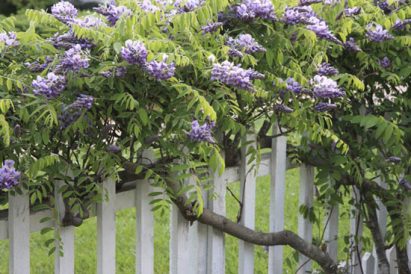Growing up I thought lilacs were the most fragrant spring flowers. It wasn’t until I moved into our current home that I was introduced to the fragrant wisteria vine, now another spring favorite! My wisteria vine is now in full bloom, and almost nothing can compare to its large, fragrant purple flowers.
Wisteria is a decidous climbing vine that is very hardy. It can grow very high and is known for its longevity. Two species of wisteria are common: Chinese wisteria (W. sinensis), and Japanese wisteria (W. floribunda). Both can grow to a height of 25 feet or more. The Chinese variety bloom all at one time, and the Japanese variety bloom gradually over a period of weeks.
Chinese wisteria blooms grow to 6 to 12 inches in length and flower early to mid-May. Depending on the variety, flowers can be violet-blue, white or dark purple.
Japanese wisteria clusters can grow 12 to 18 inches in length and bloom in late May. Depending on the variety, flowers can be white, several shades of pink or several shades of violet.
Wisteria requires 6 to 8 hours of full sun each day and moist well-drained soil. Plants become large and heavy in time, so it will need some kind of support. Wisteria grows best on structures such as pergolas, trellises and arbors. Ours is growing over the top of a pergola. Keep in mind that older plants have a trunk several inches in diameter. Make sure the support can handle the weight of a heavy vine; some purchased structures will not be able to handle the weight of a well-established wisteria vine. In addition, don’t plant a vine too close to rain gutters and other structures on your home or they may cause serious damage in time.
Pruning is required to keep your wisteria from taking over. You can trim off the top of the main branch when it has reached an optimum height. Train the main branch on the support you have attached it to, and trim and train side shoots as necessary to achieve the desired shape. In the winter, you can completely remove poorly spaced branches to improve the overall look of the vine. Pruning in late spring or early summer, after bloom time, will promote future flower production. You can cut back vines to 5 or 6 buds remaining. Pruning will actually accelerate the growth of your vine. If you over-prune your wisteria, however, don’t fret, it will grow back next year and then some.
Waiting patiently for your wisteria to bloom? If you have just planted your wisteria vine, the vine goes through a “juvenile” stage where it does not bloom for up to 7 years, so be patient and keep pruning and training the vines until the blooms appear. Make sure to plant root cuttings or grafted plants; wisteria grown from seed can take more than 10 years to achieve its first blooms.
Rachel Paxton is a freelance writer and mom who is the author of What’s for Dinner?, an e-cookbook containing more than 250 quick easy dinner ideas. For more recipes, organizing tips, home decorating, crafts, holiday hints, and more, visit Creative Homemaking at http://www.creativehomemaking.com.




